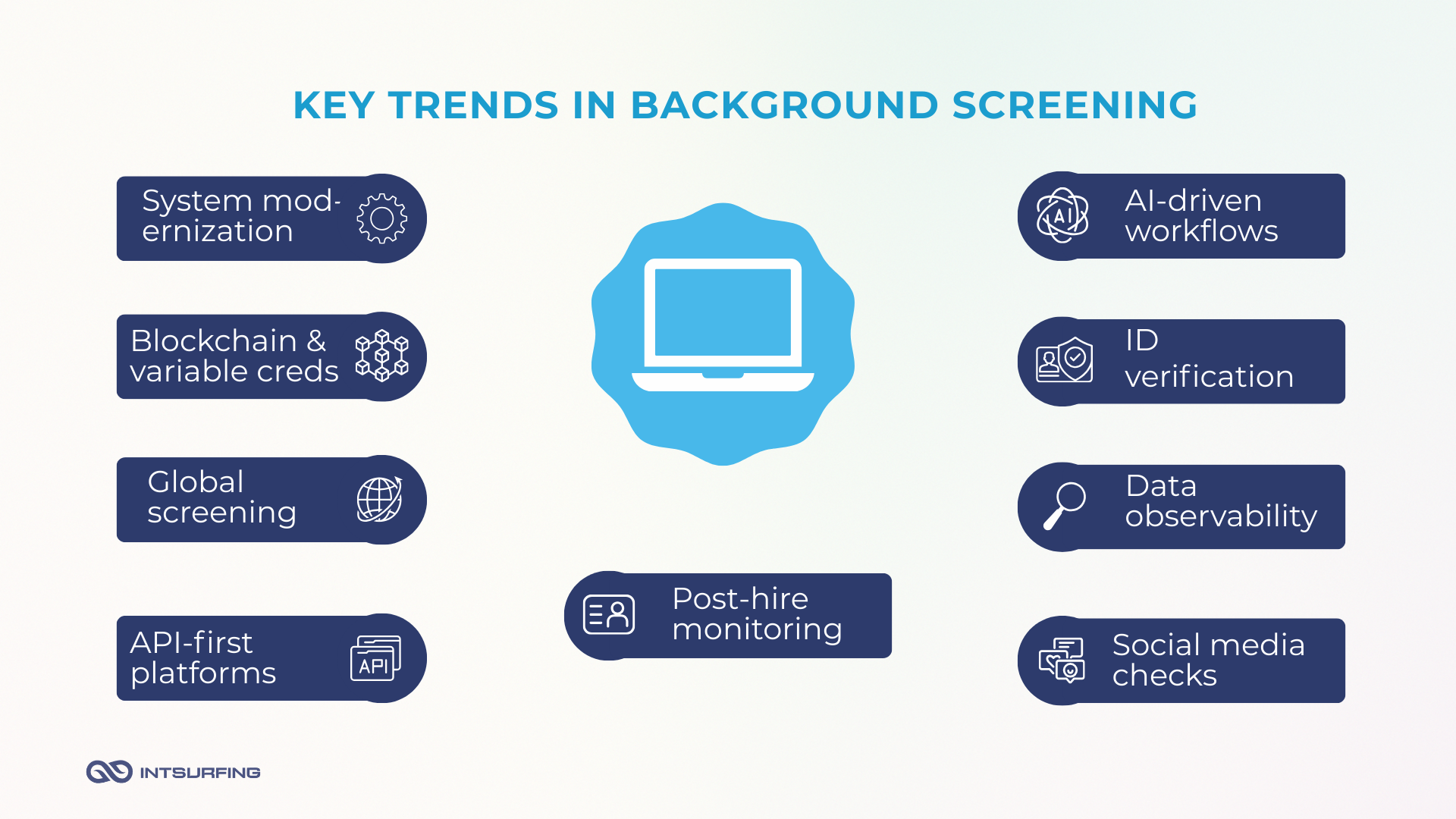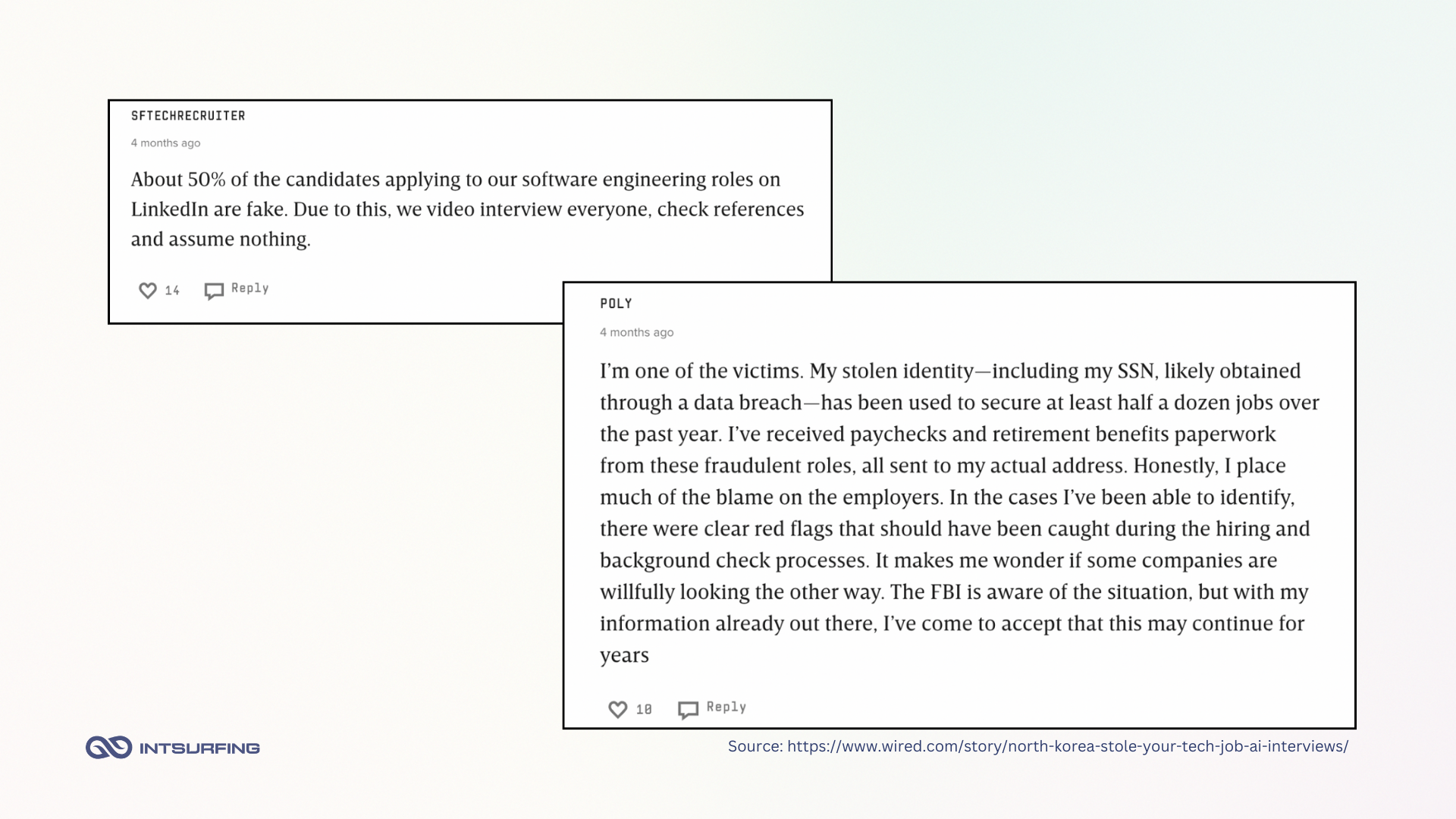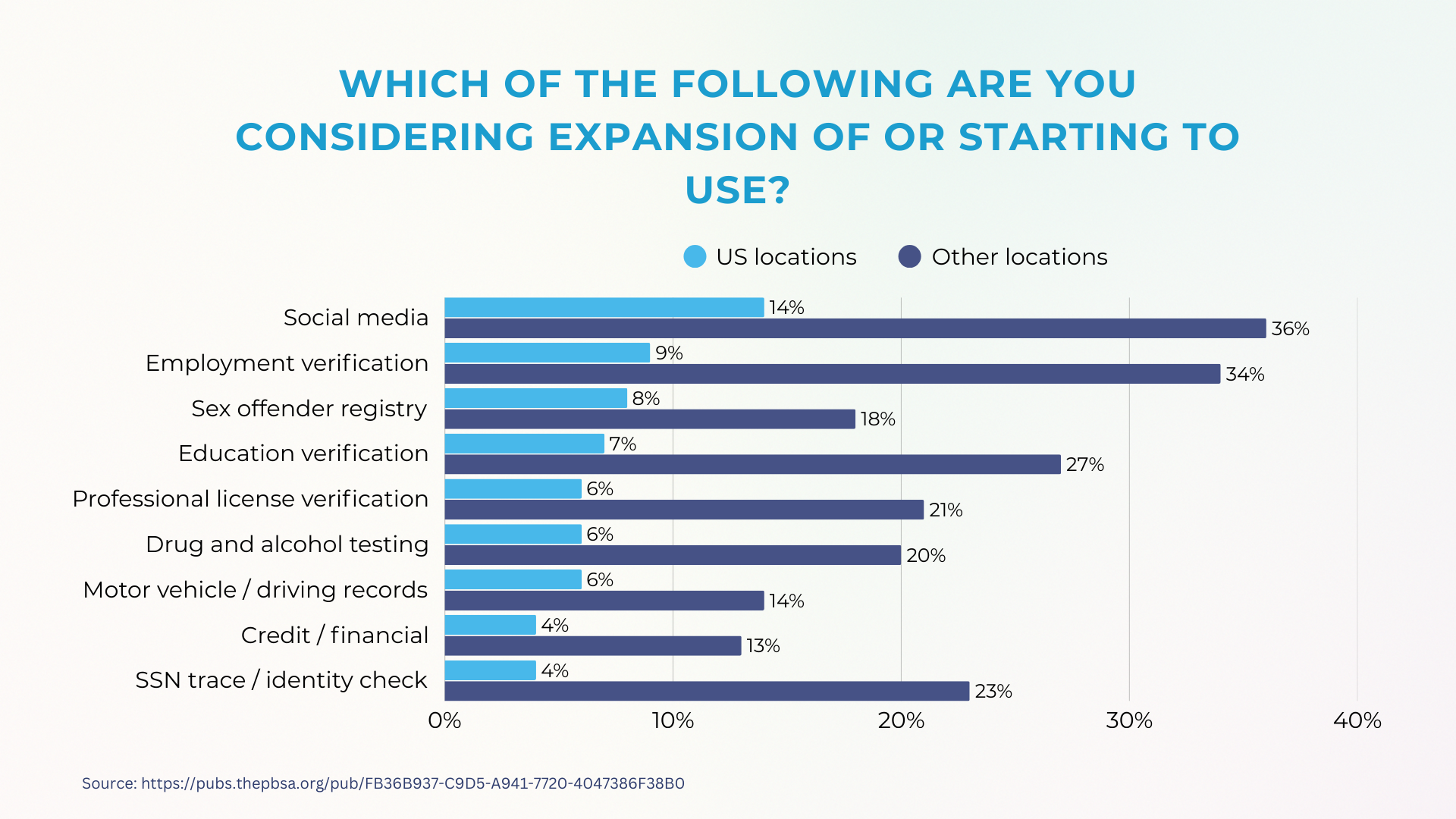The background screening industry is going through another year of change. Global economic landscape, consolidations, new regulations, and fast-moving technology are all shaping how companies compete.
In this article, we’ll focus on the trends for the product side of screening. You’ll see where the pressure points are, what innovations are under way, and how providers can adapt.
Global Economy and Screening Market Overview
The bigger economic picture sets the stage for the state of the screening market.
- The IMF projects world economy growth at 3.0% in 2025.
- Inflation has eased in major markets, according to J.P. Morgan Global Research. However, geopolitical instability could lead to price shocks, and the full impact of U.S. tariffs remains to be seen.
- Hiring has cooled. The current unemployment rate in the US as of June 2025 is 4.2%, according to the Bureau of Labor Statistics (BLS). The number of unemployed individuals is around 7.2 million.
For screening providers, that stability comes with pressure. Employers aren’t stopping background checks. But boards demand more control over accuracy and auditability when the economy is mixed.
The market itself is consolidating. Private equity investment fuels consolidation as larger firms acquire niche players to broaden services and expand geographically. Recent examples include First Advantage’s and Sterling’s various acquisitions, and HireRight being taken private (in 2024). This means fewer but larger players dominating market share. On the other hand, it also creates integration challenges (merging different systems and data sources). Nevertheless, there’s still space for smaller CRAs that modernize their technology or specialize in niche areas.
This mix of economic caution and industry consolidation makes 2025 a turning point. The companies that succeed will be those that update their technology and adapt to a new B2B buyer behavior, advisors at Iqubed say.
In the next section, we’ll break down the core trends shaping screening technology and where providers should focus their attention in the upcoming year.
Key Product Trends in Background Screening for 2025
These trends set the agenda for 2025. Below, we’ll look at each in more detail and what it means for screening providers.

AI-Powered Screening and Automation
In hiring overall, 78% of companies already use AI for at least one function (as of 2022).
Screening is catching up.
AI is applied across the workflow: parsing PDFs, resumes, and IDs, analyzing unstructured public records, predicting turnaround times, flagging anomalies in data, and helping employers interpret reports.
Here is who is using AI and how:
- Checkr to classify and explain charges, match names and roles, estimate report compilation time, and verify document authenticity.
- Certn for identity verification, document recognition, data extraction, collecting reference feedback, and screening social media.
- Bchex to gather feedback from customers and match candidate identifiers coming from different sources.
Adoption, however, remains uneven. Warden AI’s 2025 State of AI Bias in Talent Acquisition report found that 75% of HR and Talent Acquisition leaders see bias as a major obstacle to adopting AI tools. The data shows AI systems aren’t flawed: 85% of audited models met fairness thresholds, with some delivering outcomes that were 39% fairer for women and 45% fairer for racial minorities.
Jeffrey Pole, CEO of Warden AI, emphasizes that
“fear is slowing AI adoption, but… AI can deliver better outcomes and a better future for workers when it is used in the right way.”
Hence, many providers move toward “AI + HI” workflows.
There are also concerns about data security risks for PII processing. A 2024 Swimlane survey found that 74% of cybersecurity leaders are aware that sensitive information is being input into public AI models, despite safeguards in place. Echoing this, Thomas Richards, Principal Consultant at Black Duck, warns:
“In the event of a breach, candidates could become victims of identity fraud. The information collected … is all that is needed to open up a banking account or get a loan.”
AI isn’t automatically secure. Attackers wield generative tools for deepfake scams that erode trust and boost phishing. In 2024 alone, over 105,000 deepfake attacks were reported in the U.S., with losses exceeding $200 million in Q1.
So, AI can boost speed and fairness, yet its future in screening will hinge on building trust through security, transparency, and human oversight.
Identity Verification & Biometric ID Proofing
Deepfakes and remote hiring changed the risk calculus. The numbers speak for themselves.
In HireRight’s 2025 Global Benchmark Report, one in six businesses admitted they encountered ID fraud in their hiring process, while three out of 10 were not sure.
And here is a striking story on this.
U.S. prosecutors uncovered a network placing fake North Korean IT workers in American companies to generate money and fund its weapon programs. They used stolen or fabricated identities, VPNs, and AI tools to land remote jobs and route paychecks overseas.
This scheme has awoken plenty of discussions. And some people admitted becoming the victims of identity theft or deepfakes.

To be sure someone is who they claim to be, providers now combine several techniques:
- Multi‑factor verification combines something the person knows (a challenge), has (a government ID), and is (biometrics).
- AI-based document analysis scans for forgery, checks security features, and verifies authenticity with anomaly detection.
- Liveness detection ensures the user is actually present with blink detection (active) or micro-expression, pulse, and texture checks (passive).
- Device fingerprinting tracks device or network patterns to flag unusual or risky behavior.
- Knowledge-based Q&A confirms identity by asking questions only the real person should know (out-of-wallet facts).
Some companies develop these capabilities in-house. Others integrate best-in-class vendors for each layer.
For example, Checkr added Onfido’s document + biometric match so IDV can run before or alongside a background check. Sterling extended a multi‑year pact with ID.me to counter interview fraud and streamline I‑9. Entrust’s acquisition of Onfido further embedded advanced IDV into enterprise stacks.
On the other hand, First Advantage developed RightID. It pairs AI document analysis, selfie match, liveness, and KBA in a single workflow.
Data Quality & Observability
A recent HireRight survey shows that employers now rank accuracy above cost or speed when evaluating screening providers.
That makes sense.
Some background screening systems still rely on tangled pipelines and siloed legacy databases. Any unnoticed failure can yield a false “all clear” and expose employers to risk. Older infrastructures are simply not designed for full transparency or traceability.
Checkr’s engineers shared how they tackled this head-on:
“We should collect metrics and logs that indicate both when a system is working properly and when errors occur. Engineers should be able to easily find and query for failed messages.”
So, modern providers invest in deep observability. In practical terms, observability means:
- Auditability, with full traceability of every data step.
- Reliability, thanks to automatic retries and alerting.
- Confidence, through human-readable tools that prove each report’s accuracy.
Offering low-latency checks isn’t enough. Today’s savvy buyers demand background checks they can trust and verify.
Public Web & Social Media Data
A CareerBuilder survey shows that around 70% of employers check candidates’ online profiles. Among employers who conduct social reviews, 43% say posts convinced them to move forward with a candidate, while 57% found content that made them not to. But in most cases, this is done undocumented.
Veremark notes that social media checks are moving away from informal rejections. In fact, 25% of employers are considering or have started formalizing the process through social media screening. Importantly, most HR teams don’t do this in-house because of legal risks and partner with specialized providers.

Thus, driven by employers seeking a fuller picture of candidate behavior, the social media screening market has grown into its own ecosystem.
- Fama, Social Intelligence, and Ferretly focus almost exclusively on monitoring candidates’ digital footprints, relying on AI to flag harmful behavior.
- Established CRAs (HireRight, Sterling, Accurate, and First Advantage) have added social media checks as part of broader employment screening suites, often through partnerships with these niche players.
These providers run image and text analysis to flag hate speech, threats, illicit‑drug imagery, etc., followed by human review before release.
Post-Hire Screening
Major providers are now offering workforce monitoring services (also called rescreening or post-hire checks) as add-ons.
The momentum is fueled by a culture of workplace safety: 82% of job candidates say feeling safe at work is highly important, and companies see ongoing screening as a way to uphold that safety commitment.
Regulated industries (transportation, healthcare, finance) already mandate periodic checks: annual driver’s license abstract pulls or regular credential verifications. But the practice is widening to general employment. Recent figures from PBSA show that around 19% of employers now include continuous screening as part of their background check programs. In other words, the vast majority still have no routine post-hire check in place, though momentum is growing.
Modern monitoring architectures often involve event-driven alerts. For example, if an employee is booked in a county jail system or added to a sanctions list, an API triggers a notification to the employer’s dashboard. Building this requires robust integration and data engineering to continuously sync with various data sources without overwhelming the system (incremental checks, scheduling, and handling of data changes are key).
API-First Platforms
Background screening has moved beyond logins and portals. Today, API-first platforms power speed, flexibility, and automation in hiring workflows.
Checkr’s 2024 “Every Check Counts” survey of 1,850+ large employers shows 75% of HR and talent leaders say flexible API tools are essential to enhance candidate experience and efficiency.
What this means in practice:
- Instantaneous triggers—background checks start at the exact moment a candidate hits the right stage in the hiring process.
- Modular design—teams pull only what they need (e.g., criminal, ID, driving).
- Scalability—these platforms handle millions of requests, with failover and uptime baked in.
That is why many providers now offer pre-built integrations with Applicant Tracking Systems (ATS) and HRIS platforms.
On the horizon are compliance-aware workflows built into the API: auto-clearing clean cases, escalating edge cases, and integrating with microservices-based hiring platforms.
Modernizing Legacy Screening Infrastructure
Many long-standing background check firms still rely on siloed, on-prem systems built decades ago. These legacy platforms struggle with speed, global scale, and integration.
Cloud migration is accelerating in response. For example, AWS reports a 35% surge in demand for cloud-based background check services within financial services and healthcare—sectors with strict compliance demands.
Additionally, the system modernization is partly driven by recent industry consolidations. Legacy platforms get fragmented when, for example, First Advantage integrates acquired systems—now worth more than $1.5 billion in combined revenue—into one stack. Their $2.2 billion 2024 acquisition of Sterling brought this architectural challenge front and center.
Even outside of M&A, the need for interoperability is growing as clients expect one-stop global solutions with criminal, credit, ID, driver’s records, and more across SAR countries, APAC, and LATAM. Legacy systems layered across geographies can’t handle that.
Blockchain and Verifiable Credentials
VC adoption in recruitment is still nascent. For instance, Certn place it in their “future roadmap”:
“Background checks may leverage blockchain to maintain immutable records of individuals’ backgrounds, enhancing data security and transparency in the screening process.”
So, why is this important for screeners?
Digital, portable credentials drastically lower verification friction. Screening teams stand to benefit: fewer manual checks, faster offers, and strengthened data integrity.
The road ahead spans a couple of stages:
- Pilot & hybrid adoption. Expect credential-issuing bodies (universities, certifiers, and regulatory agencies) to lead early development.
- Industry convergence. As standards (W3C VC, DIDs) mature, expect regulated hiring markets to adopt interoperable credentials across global CRAs.
- Mainstream integration. In 3–5 years, expect some screening platforms to accept personal VC wallets from candidates.
In short: blockchain-backed verifiable credentials are not here yet, but they’re already reshaping adjacent identity fields and poised to transform background screening first in high-stakes sectors.
Global Screening and Localization
A HireRight survey found that nearly 90% of global employers conduct criminal checks on international hires, and 60% verify identity. But over three-quarters detect discrepancies in candidate-supplied info across geographies.
As companies hire globally, they face challenges in each country: from verifying identities and credentials across borders to complying with laws.
While not new, it’s worth watching how providers innovate here.
Expect more AI-powered translation of non-English records, API-first connectors into local data sources, and enhanced consent flows that adapt per jurisdiction (e.g., Europe, APAC, LATAM). For example, hiring platforms now automatically switch their consent dialogue to meet local privacy norms.
Conclusion
Consolidation, regulation, and new technologies reshape how providers operate—from AI-driven analysis and API-first platforms to blockchain pilots and global coverage models. Yet the core mission remains the same: delivering accurate, fair, and trusted results.
What comes next is less about adopting every new tool and more about finding the balance between innovation and responsibility. Companies that modernize their data pipelines, invest in transparency, and adapt to global hiring realities will set the standard.





